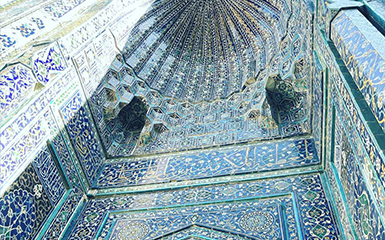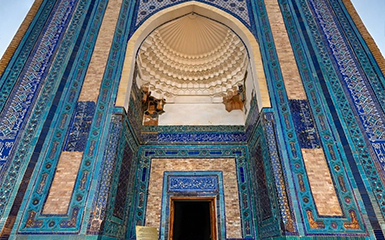Bahauddin complex
Char Minar
Lyab-I Hauz complex
Poi Kalan complex
The Ark Citadel
Bolo Haouz Mosque
Kalan Minaret
Islam Khodja complex
Itchan Kala
Kalta Minaret
Kunya Ark
Kutlugmurat Anak
Alla Kuli Khan
Muhammad Rahim Khan
Muhammed Emin Khan
Pahlawan Mahmud
Tash Hauli
Juma Mosque
Andijan
Muynak
Rabati Malik
Shah-i-Zinda is one of the most famous necropolises in Central Asia, the mausoleums of which were built between the 9th and 19th centuries. From the 14th century, the Timurid nobles were buried here. The well-preserved buildings are located in the north-eastern part of the city of Samarqand in Uzbekistan on the slope of the Afrasiab valley.
The name Shah-i-Zinda is connected to a legend according to which the cousin of the Prophet Mohammed, Qutham ibn Abbas, is buried here. He came to Samarkand with the Arabs in the 7th century to spread Islam. He lost his head for his firm belief but according to the legend, he never died. He took his head with him and disappeared into the depths of the well that leads to the Paradise Gardens. He still lives there today. Shah-i-Zinda means ‘Living King’ and the name of the complex is his heritage.
The Shah-i-Zinda complex was expanded over nine centuries (from the 11th to the 19th centuries) and now has more than 20 buildings. The entire complex is divided into three parts. The lower, middle and upper buildings are connected to each other by four arches (chartak).
The oldest buildings are dated to the 11th and 12th centuries. Only the foundations and tombstones have survived from them. Most of the buildings date from the 14th and 15th centuries. The reconstruction work between the 16th and 19th centuries did not significantly change the shape of the tombs. The main part of the area is the Qutham-ibn-Abbas complex. It is located in the north-eastern part and consists of different buildings. The oldest of these are the Qutham-ibn-Abbas mausoleum and a mosque from the 16th century.
The upper structure group consists of three tombs facing each other. The oldest is the Shrine of Khodja-Akhmad, which completes the crossing from the north. The middle group consists of shrines of the last quarter of the 14th century and the first half of the 15th century. Related to relatives of Timur, military and clergy aristocracy. On the western side, the Tomb of Shadi Mulk Aga, Timur's nephew, stands out. This portal-domed, one-story underground mausoleum was built in 1372. Opposite it is the Mausoleum of Sirin Bika Agha, Timur's sister.
Near the multi-step staircase are the best-proportioned buildings of the subgroup. There is a double dome shaped mausoleum built at the beginning of the 15th century. This shrine is dedicated to Kazi Zade Rumi, a scientist and astronomer. That is why the double dome mausoleum built by Ulugbeg in 1434-1435 over his tomb has a height comparable to the smaller domes of the royal family shrines. The main entrance gate of the community ("Darvazakhana" or the first "chartak") facing south was built in 1434-1435 by Ulugbeg.


